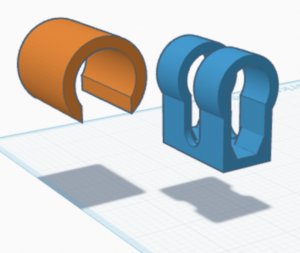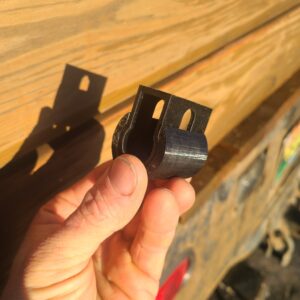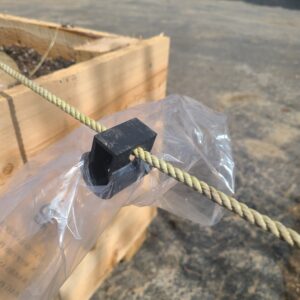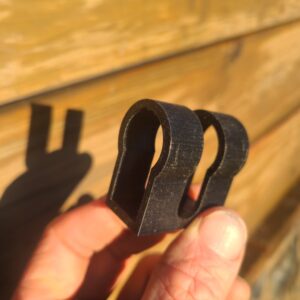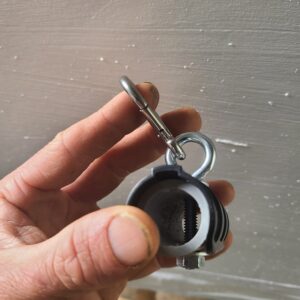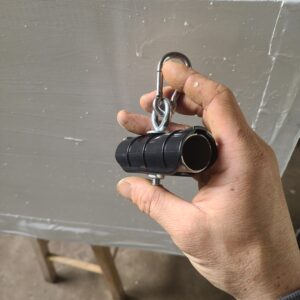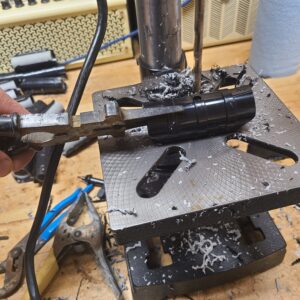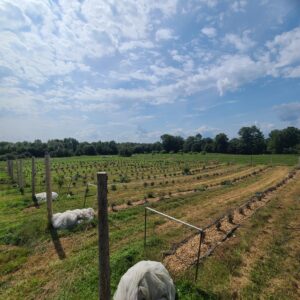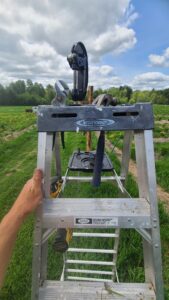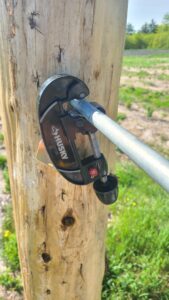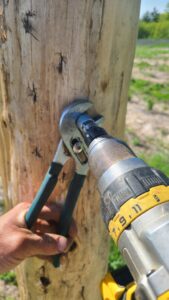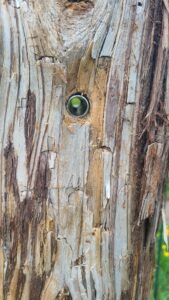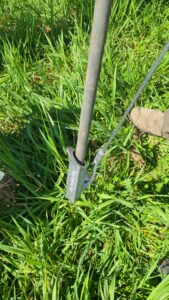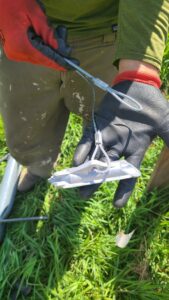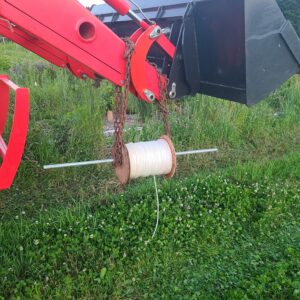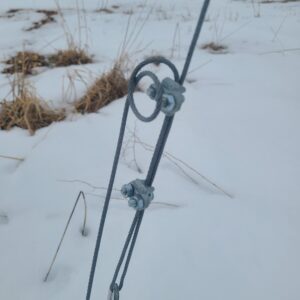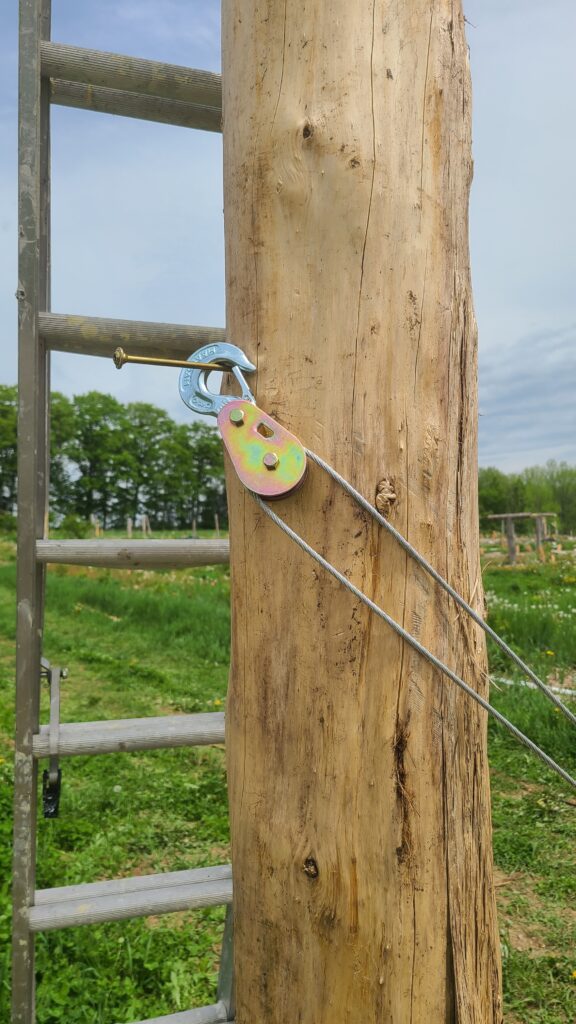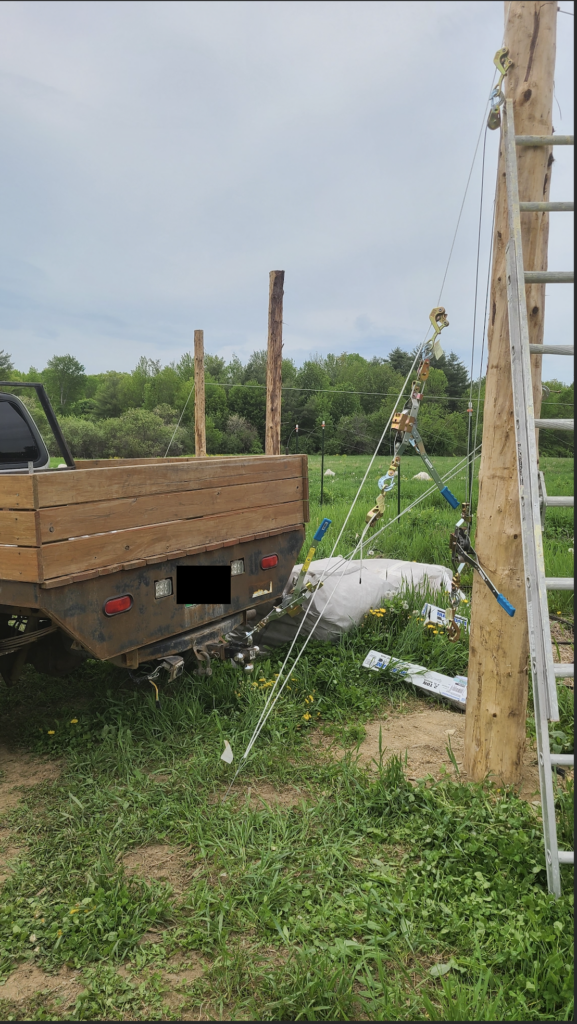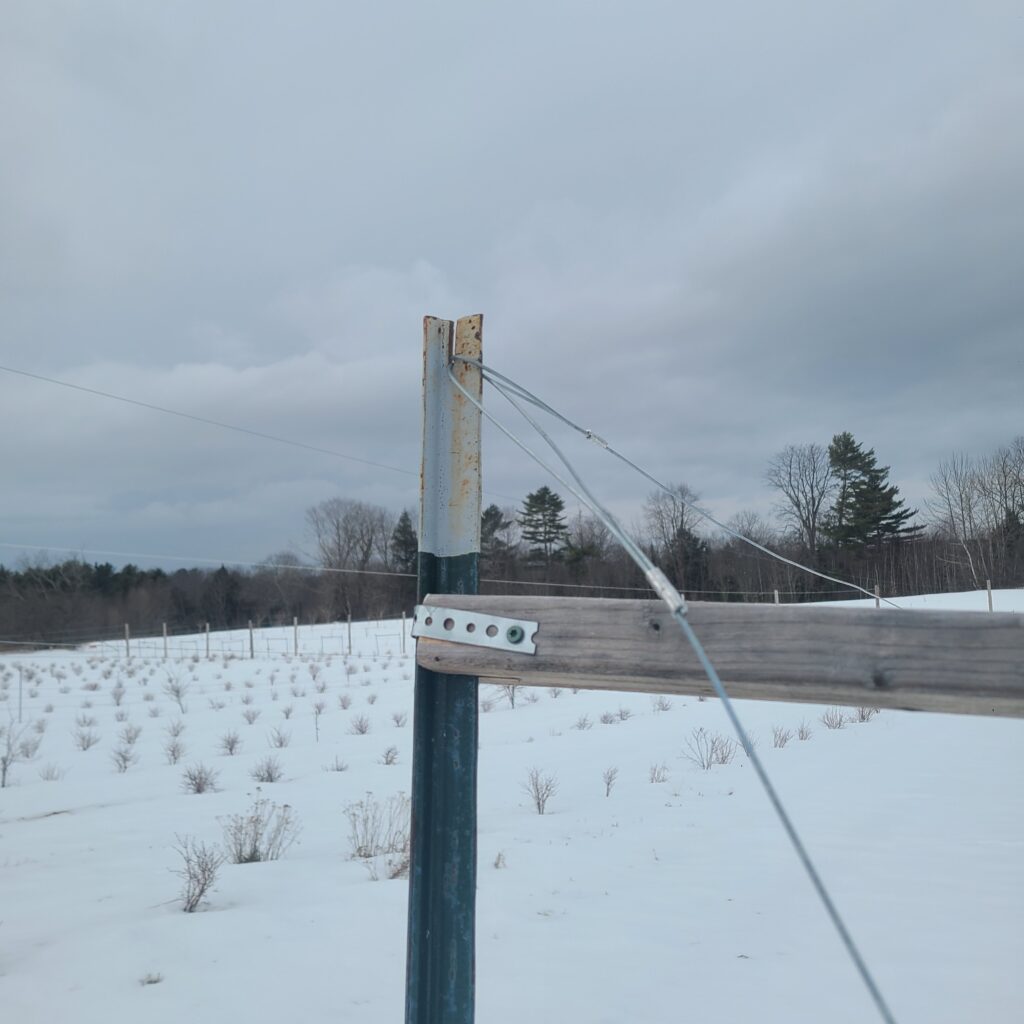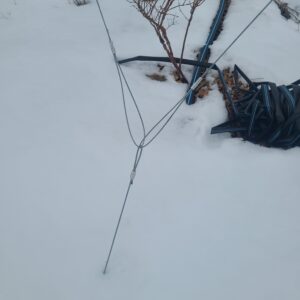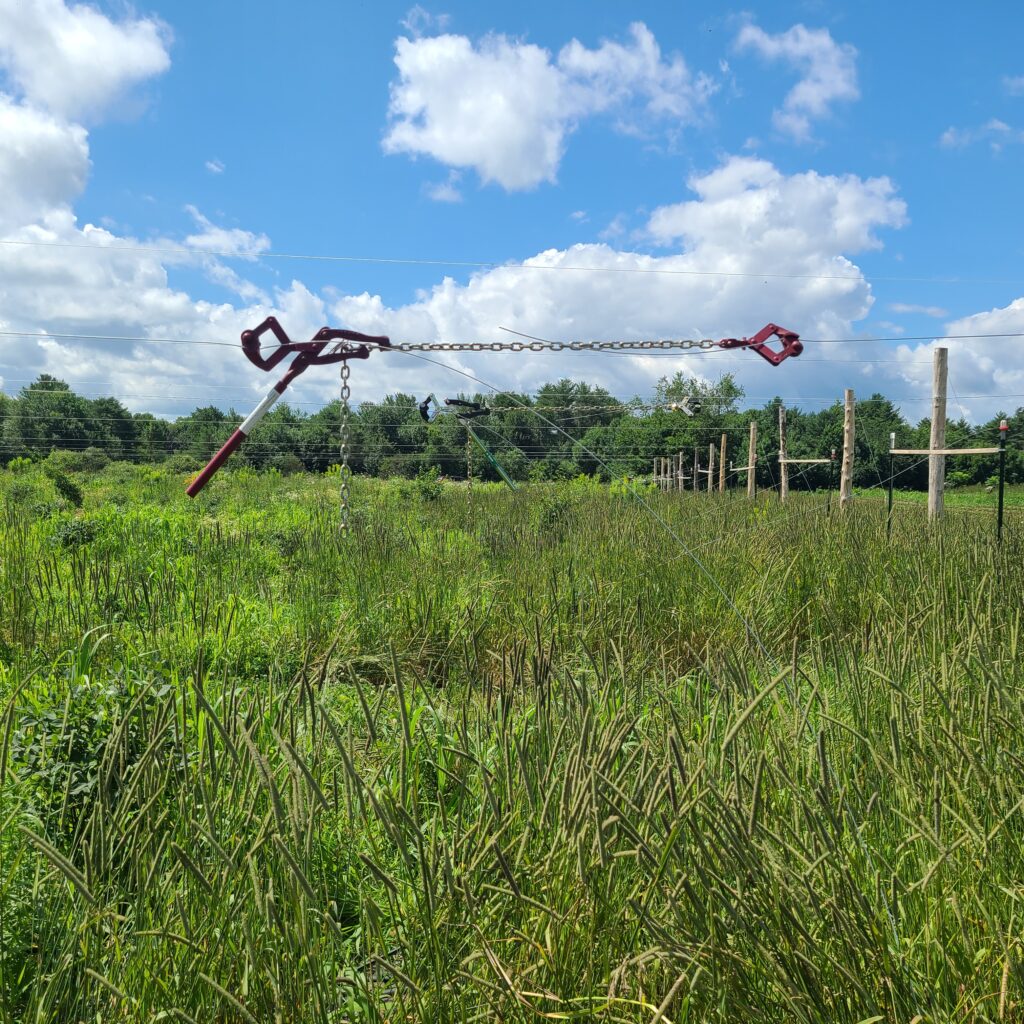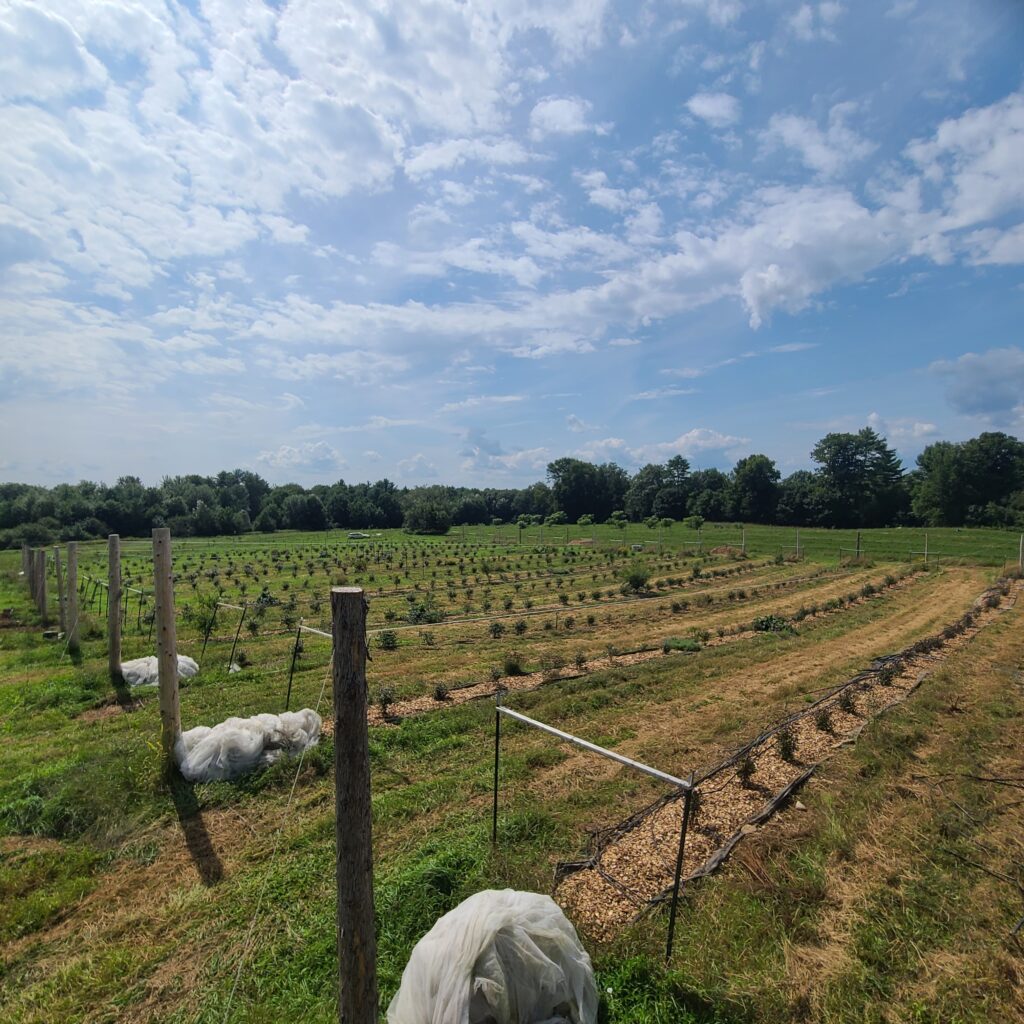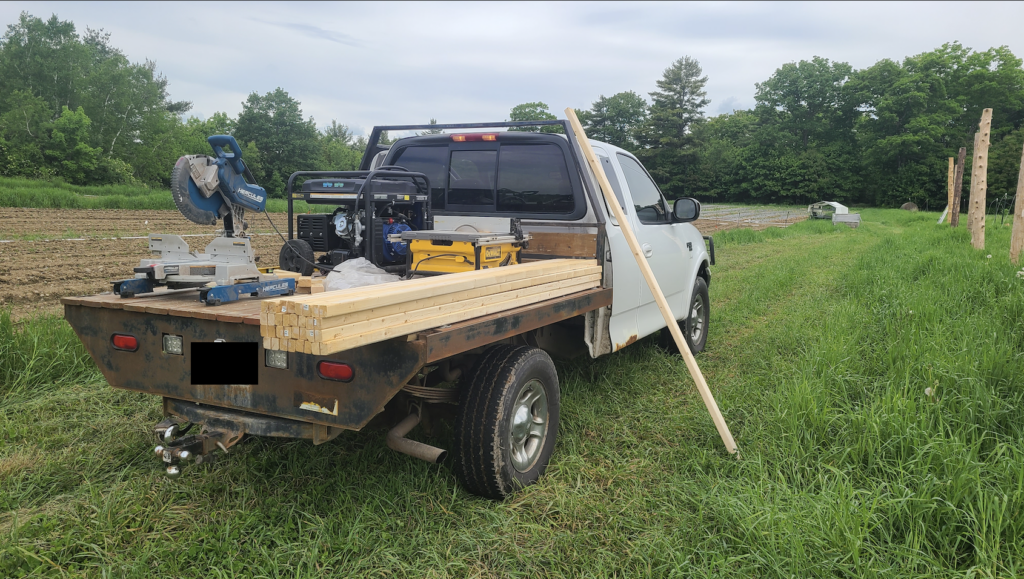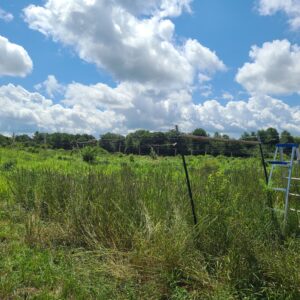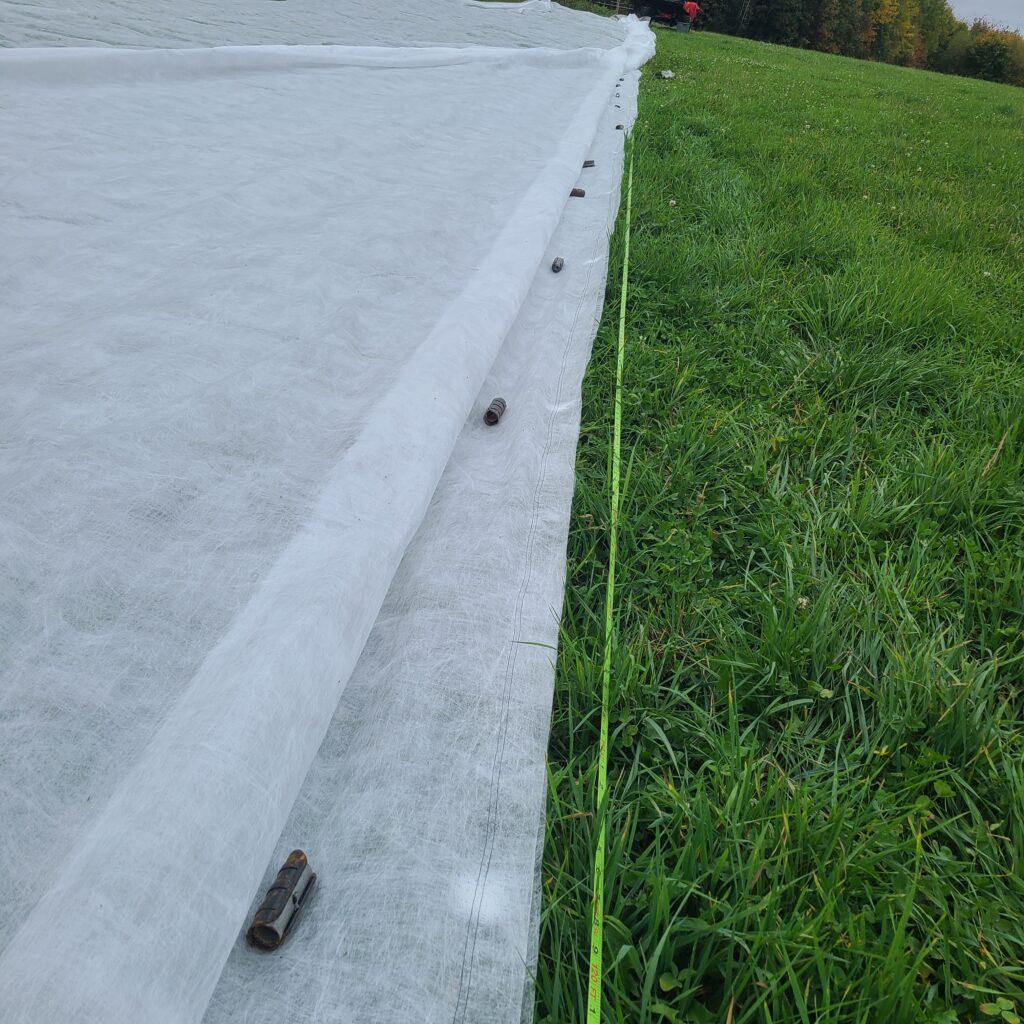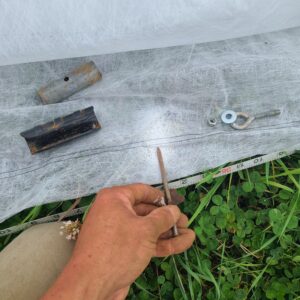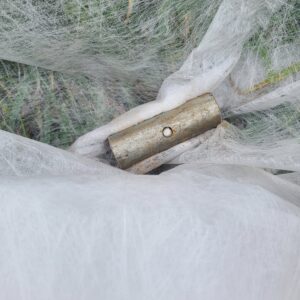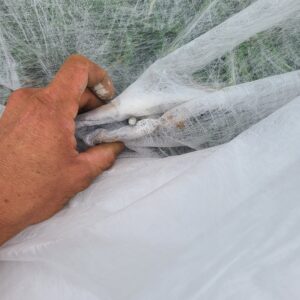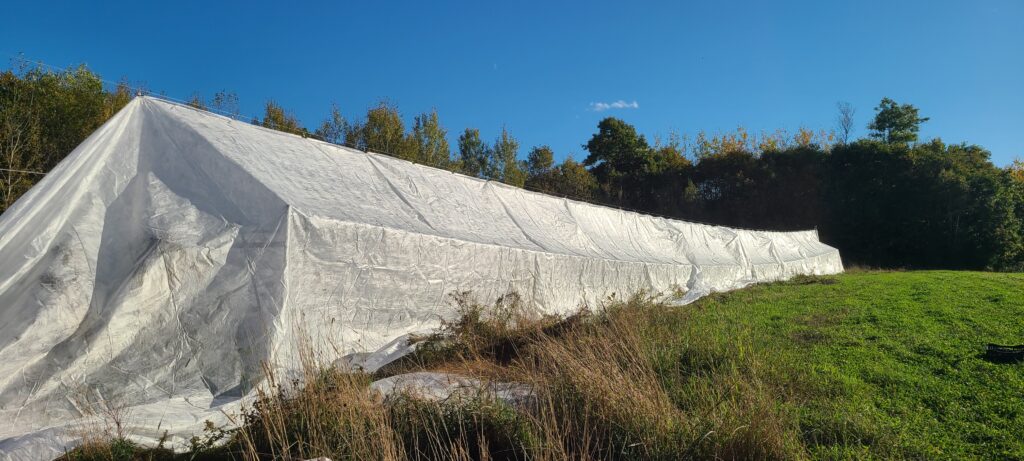Progress report for FNE24-074
Project Information
This project seeks to:
- Construct and compare a set of plans for a post and wire zipline trellis support structure. It will be made from materials that growers can readily purchase through building and farm supply companies, as well as through 3D printing.
- Compare varying material option combinations for project construction to offer feedback to farmers looking to replicate the system. (See attached chart.) This will include qualitative observation as well as material cost/labor analysis.
- A 3D-printed model will be tested, and refined designs will be made freely available on the Internet for others to use.
- The efficacy of the system will be tested. Yield/yield loss data will be collected comparing SWD damage in the farm's raspberry and blackberry rows covered with 70g Proteknet and Typar T-518 against open field conditions. Yield/yield loss comparison will be collected in the honeyberry block comparing the various netted rows and open-field control rows for bird exclusion.
- Temperature/humidity data will be collected under the different netting materials and considered for correlation with crop yield differences.
- I will teach growers how to construct their own support structures through social media posts, two on-farm field days, and a MOFGA newsletter article in the second year.
Crop loss due to bird/insect pressure is one of the primary issues affecting berry farmer's. A 2012 study by Cornell University calculated the average annual economic impact from bird damage to just five of New York State's fruit crops to be $16 million [Lindell 2014]. Similarly, farmers in the U.S. are contending with the spread of spotted-wing drosophila (SWD), a small fruit fly capable of laying its eggs into soft-fruited crops. It is estimated that SWD causes $500 million in economic losses to farmers in the United States annually [Roche, 2021].
Finding an appropriate solution to both cedar waxwings and SWD is at the forefront of my mind. SWD was especially challenging with my day-neutral strawberries and raspberries this past season, and the cedar waxwings consumed much of the fruit produced on our young honeyberry plants. With a vision of offering pick-your-own options throughout the summer, our farm is unfortunately also creating bridge crops for birds and SWD to remain on the land. A solution is needed that will work for our context.
Amongst available strategies, exclusion netting trellis systems are particularly effective against both birds and insects. Through SARE grants (FNE14-813/FNE20-963), Dale-Ila Riggs of The Berry Patch reduced crop losses in her blueberries and raspberries due to SWD from 40% and 25% respectively, down to 0.50% through a whole-field exclusion netting system of 80g Proteknet [Riggs, 2023].
At $25-28k per acre, however, whole-field systems have a prohibitive barrier to entry to some farmers, and require concentrated labor at key points to deploy and disassemble the netting each season. For Dale-Ila Riggs, it takes three people 8 hours to to deploy, and 6 hours to breakdown for winter storage [Callahan, 2022]. Indeed, a 2014 survey conducted by former UVM undergraduate Hannah Lee Link of northeastern berry farmers found that only 2.5% of respondents utilize insect netting to exclude SWD, with the primary reasons given for not doing so related to material costs and labor [Link, 2014]. While bird netting is significantly less expensive than Proteknet for exclusion, these cost considerations remain the same for installing any large exclusion system.
Link's research highlights the considerations a netting system would need to address for farmers to adopt the cultural practice. A general summation is that farmers seek an affordable system that can be built from readily available materials. They expressed preference for a large structure one could walk into versus netting over individual rows out of specific concern that the netting would be in the way for maintenance/harvest, and with the labor associated with deploying it. Machine access was strongly important to respondents, and that the system needed to be able to withstand winds and be easily deconstructed for winter storage.
A whole-field netting system is not ideal for our farm's setup. Beyond the already high cost of construction, our perennial crop rows are spaced further apart than is typical to allow rotational alleycropping of our strawberry crops. Labor limitations would also make deploying/dismantling a whole-field system a challenge for my farm. I believe, however, that the zip-line design I lay out in this proposal can be managed entirely by a single person after initial construction. The design will significantly lower the cost per acre to install versus a whole-field system, and, importantly, will address farmers' concerns of single-row netting being in the way for maintenance and harvest that Link's study described.
This SARE grant will investigate this novel trellis netting system. Drawing inspiration from childhood zip-lines, I propose to install something similar over our berry crops. I will bury posts at the ends of 18 perennial berry rows, and run a guy-wire spanning the crop row. Exclusion netting will then be attached to form a double curtain that can quickly be drawn and withdrawn from over the crop, and secondary support wires will create an internal canopy. The effectiveness of different hardware materials readily available to farmers and different netting options will be assessed during this project.
I believe this trellis netting design will greatly decrease crop loss from birds and SWD. Netting can be stored for winter wrapped around an end post, and I estimate a single person might deploy a row of netting in 20 minutes in the spring. It should take 10 minutes for harvest/maintenance after that. For farmers on a budget, or who have sub-acre crop plantings, I believe it is possible to install an exclusion affordably. This design will reduce crop loss and increase profitability in a manner that can address both SWD or bird predation.
Cooperators
- - Technical Advisor
- - Technical Advisor
Research
The goal of this project is to test and evaluate a novel trellis system for excluding birds and spotted-wing drosophila from perennial berry crops, and to collect field data to support the project's conclusions. Data collection was proposed to begin in 2024, but design troubleshooting and the reality of the farm's production season led me to focus on construction alone last year. At this point, all the infrastructure is in place for installation of the netting this spring, but some adjustments are needed that will be discussed later.
The proposed trellis structure at it's basic is two 14' cedar posts installed at each end of a crop row with a guy wire suspended above the crop with netting attached that can be drawn over the crop like a curtain. The guy-wire passes through the cedar posts and is secured using duckbill anchors. Two t-posts are also installed at each end of the crop row with tensile wire tensioned between them. These secondary lines are intended to keep the netting away from the crop. Installation and the challenges I encountered will be discussed in detail in the next session.
Various materials are proposed for testing in this project to be able to offer feedback to farmers:
This growing season, 2025, I will make adjustments to the infrastructure, install netting, and track operating time to deploy the system, crop yield, and temperature/humidity readings beneath the netting.
The bulk of this section will explain the timeline, process, and redesign undertaken last season. Most went well and was straightforward in terms of installation, but a couple elements needed to be re-approached, and a few remaining concerning heading into the new year.
3D-Printed Hardware:
Heading into the project in the Winter/Spring of 2024 believing that we would be able to install everything in April, 3D-printing for the project began immediately after award of the project funding.
I took time to redesign the proposed 3D model because I realized the design would require filament supports successfully print the existing overhangs, which I wanted to avoid. This is the redesign I settled on for the project:
The new model can be printed without supports. Where the original design called for 15.25 meters of filament per paired hardware and a 1h2m print time, the new models require 6.93 meters and can be printed in 33 minutes (using the AD5MP). The model was printed with using PETG filament as planned with 15% infill density using both a Flashforge AD5MP and a Creator Pro 2 printer with .6mm nozzles.
EMT/PVC Hardware
Prepping the EMT/PVC hardware also began in March. 10' lengths of 1" PVC and 1" EMT were measured and cut down to 3" pieces. I use a chop saw for the PVC, and an angle grinder with a cut-off wheel for the EMT. The EMT conduit needed further processing to deburr the cut edges with a conduit reamer and chamfer, which added significantly more processing time than the PVC. The PVC, on the other hand, produced a lot of microplastic waste that was difficult to clean.
I used an inexpensive benchtop drill press to make holes in the EMT, PVC, and greenhouse clamps. The most efficient way to do this was to snap the clamp onto the EMT and PVC and drill through both simultaneously. This also ensured that the holes would align perfectly.
One concern that arose is the fit between the EMT conduit and the snap clamps is looser than that of the PVC. The diameter of the EMT is actually .92" not 1". I will be assessing whether this is an issue in the field.
Spring - 2024
Installing Cedar Posts & T-Posts
West arrived in April and to assist in putting energy into installing the 14' cedar posts. We used a tractor-mounted post hole digger with an 18" auger to initially excavate the holes. Most needed additional manual labor to remove soil and get them down to 36-48" in depth. We ran into significant ledge with a few holes, and used a hammer drill powered by a generator to break deeper into it. A tamping bar and level were used to set the posts.
8' t-posts were installed inset from the cedar posts to help support the fabric away from the crop using high tensile wire. Issues arose installing that tensile wire, and will be discussed later in the report.
Drilling the Guy-wire Holes
A 1" diameter hole was drilled through the post at a height of 10'. I found that running the guy-wire directly through the drilled hole created problematic rubbing. It was causing the rope to fray and the air craft cable to cut into the cedar post and jam. The solution to this was creating 1" EMT conduit inserts for the hole (shown in the photos above).
Each EMT insert is a custom length because the diameter of the cedar posts is variable. For each post, I would insert leftover lengths of EMT, mark it with a sharpie where it needed to be cut. After cutting the pipe with a pipe cutter, I used pliers and the drill bit reamer on the cut end to smooth any sharp edges, then tapped it into place with a hammer.
Duckbill Anchor Installation
The next step in the process is to install the duckbill anchors 4' away from the cedar posts. We found that the best installation method is to first use a t-post pounder to set the anchors, then switching to a 6 lb. sledge once the t-post pounder makes ground contact to finish it off. This proved quickest method, with least wear on the body.
Installing the Guy-Wires
The first step to installing a guy-wire is to pull out the guy-wire line. We did this off the tractor bucket using EMT conduit and chain to elevate the spools. I climbed a ladder to thread the line through the first insertion hole, then walked down and repeated this step using a second ladder on the other side. The important thing is to maintain a steady pace as you walk but then slowing down while maintaining tension to the rope so it doesn't over-spin on the spool when you stop at the end of the row.
At the end of the row, I looped the line through the duckbill anchor and secured it off. For the aircraft cable, this is done with two 1/8" steel rope clips. For the poly-rope, this is with a bowline, as an easy to undo knot. For the aircraft cable, it requires two steel rope clips (see photo above). The orientation of the steel rope clips is important. The saddle should be against the "live" end, while the nuts should be on "dead" end.
Bolstering the Cedar Posts for Wire Installation
The next step is to insert a structural screw on the inside of each of the two cedar posts, in line with the crop row. This is to ensure that the cedar posts aren't pulled inwards when tensioning the guy-wire. I parked a large vehicle on each end of the crop row, and ran a come-along winch from the vehicle to the structural screw and ratcheted it under tension.
Once the cedar posts are well-anchored, I fed the loose end of guy-wire through the duckbill anchor to tighten the line. The wire thimble hardware, placed in the wire loop of the duckbill anchor, is critical for this step. Without it, both the aircraft cable and the rope struggled as they were tensioned. The thimble allows them to slide easily.
Tightening the Guy-Wire
Tightening the guy-wire requires two come-along winches and four one-ton cable grips. The cable grips are attached to the come-alongs, and make it possible to grab on and tension the guy wire. You tighten the cable as much as possible by hand, then climb a ladder leaned against the cedar post to attach one end of the come-along to the end of the guy-wire. The other end of the come-along is attached to the loose end of the rope. This then allows you to ratchet the come-along and pull the guy-wire tighter.
However, this needs to be done several times. This is where the second come-along setup comes into play. With the second winch, you leap frog over the first come-along and continue to tighten the line. When the tension has slackened to the first come-along, you can remove it safely. This leapfrogging process needed to be done at least three times. The poly-rope needed more repetitions than the aircraft cable.
Summer 2024
T-Post Secondary Line Installation
Multiple issues came up installing the high tensile wire as secondary lines for the t-posts.
First, it was impossible to pull the tensile wire strongly enough by hand to tighten the line between the t-posts, and the 1-ton cable grips used for the guy-wires were insufficient. The cable grips are unable to latch onto the thin, smooth gauge of the high tensile wire. A fence strainer is the tool needed for the job.
Step One is to cut notches in the top of the t-post using an angle grinder and cutoff blade. The Lockjawz product I purchased for this step was not strong enough for the force applied by the high tensile wire. This was the solution. (see below).
Step Two was to install a duckbill anchor in the ground and secure the t-posts using high tensile wire with loops crimped on each end (see above). In retrospect, as I will describe later, this is not how I would recommend securing the secondary lines. Better would be to install one duckbill anchor per t-post and have its installation location be in line with the secondary line.
Step Three is to draw out tensile wire along the length of the crop row using a Spinning Jenny, and crimping loops on each end. These loops are also inserted into the notch of the t-post. (see above, as well)
Step Four is to cut the high tensile wire somewhere along the line, and use a fence wire strainer to tension the secondary wires, then tie a high-tensile quick knot. This is a technical fencing knot, but one with tutorials readily available on the Internet.
Troubleshooting...
Note: It proved important for me to do this step to both secondary lines simultaneously because I connected both secondary lines to a single duckbill anchor. I did this thinking to save on material costs, as well as to have fewer areas I needed to mow around carefully in the future, but it ended up causing frustration and cost additional labor. Tightening just one line began to warp and bend the t-posts in towards each other due to the duckbill anchor placement and the forces put upon them. I had to pause this step of the project and order a second wire strainer, and to consider how to prevent the t-posts from collapsing towards one another.
- What I came up with as a solution was to purchase 8' 2x4s. These were then custom cut and notched in the field to fit between the t-posts and secured using metal tape and screws (See photo below for 2x4s in place. See photo above for a photo of the metal tape used to secure the 2x4 to the t-posts.
- I brought my chop saw and table saw into the field on my truck with a generator and cut notches in the 2x4s to fit securely to the t-posts. These steps occurred between Steps Two and Three, but I do not believe are the best course of action.
- When the second wire strainer arrived and both secondary support wires were tightened simultaneously, the t-posts with the 2x4s between them exerted equal force upon each other, which prevented them from collapsing inward.
Further Troubleshooting, and potential solutions...
While the t-posts no longer bent inward towards each other, a new problem presented itself: The tension of the high tensile wire caused them to lean inward toward the crop (see above). At the time I felt this was acceptable, but increasingly feel that the correct direction is to install one duckbill anchor per t-post set back at least 6'-7' (the height of the t-post). This small change should eliminate the t-posts bending in either direction, will no longer require the 2x4s, and should allow the high tensile wire to be put under greater tension than it currently can be under.
Netting Installation
West's and my time together ran out, and installation stalled from May through July with the demands of the farm season. I underestimated how long the installation would take and the way in which the farm season would affect the project. It took until late-summer for me to have the time to put more energy into the project and get the first netting installed (Typar T518).
To install the hardware, I first drew the row cover out along the ground, followed by a 300' tape measure. The Typar T518 was folded in half with a sewn seam at the center line that I lay along the tape. I walked along with a spray can to marked every 4' where the hardware would be installed.
Shown in the picture below is all the hardware needed by the white paint marks. I arranged the row cover to be able to reach underneath and install the EMT conduit hardware and snap the clamp into place. A nail was used to poke a hole in the row cover for the eyebolt to easily pass through the fabric. I tightened the washer and bolt with a ratchet wrench.
From there, it was a relatively easy job to climb a ladder and attach the "netting" to the guy wire.
Future troubleshooting...
There was some noticeable sag in the guy wire from the weight of the Typar T518, which is a pretty heavy fabric. I noticed the weight showed some pulling on the cedar posts, so have installed duckbill anchors that I plan to run tensile wire from to help anchor and prevent this from happening.
Another issue, and perhaps the largest for the project, is that the row cover very much caught wind. To the point that a strong autumn wind picked it up and tangled it drastically. The t-posts ripped through the fabric in some places. I will troubleshoot the anchoring, but this indicates that this system might not be well-suited to "netting" options that don't allow significant airflow. I may limit the number of rows I install row cover to as I assess. If it is the case, this system may only do well for excluding birds not SWD.
A last final issue. The blackberries I was establishing on the farm that were to be part of this project did not fare well last season. I will assess once they break dormancy in the spring, but I may choose to eliminate their consideration from the project.
West will be arriving back this April to put more energy into the project. We will anchor the cedar posts, modify the t-post setup, and installing netting. I anticipate being ready to collect harvest and field data for this coming season.
This project is still in progress. I have made good headway installing the system and troubleshooting aspects that needed redesign, but the system may only prove worthwhile for excluding birds from berry crops, not as an exclusion system for spotted-wing drosophila. I will be tweaking the design this season to determine if this is the case.
Education & outreach activities and participation summary
Participation summary:
To this point, I have not conducted a substantial amount of outreach. I wanted to have proof of concept in place before doing so. The most substantial was giving private tours to several farming friends over the summer. Beyond that, I made a social media post on Instagram to announce the start of the project, and speaking about it with customers when they visited the farm's strawberry u-pick in July.
I will pursue outreach this season after West's visit when the netting is fully installed.
Learning Outcomes
So far, I have given a few private tours to farming friends who have visited the farm last season. This was more of a general overview of the project vs. getting into the details of what did and did not work, and is before I got the first net in place.
Project Outcomes
The outcome of this project is still in testing, and it may prove not to be suitable for SWD exclusion, but I am optimistic that the work I am doing will make all the difference in protecting the honeyberry crop from cedar waxwing predation.
The primary areas that need further work for installation include:
- improved anchoring of the t-posts to eliminate their bending under tension
- improved anchoring of the cedar posts under the weight of netting
- assessment of using row cover in light of initial performance with strong winds.
as well as:
- harvest yield data
- temperature/humidity measurements under the netting
- time studies working with the system

